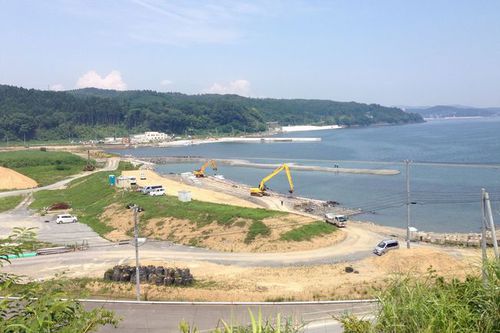January 29, 2017
Environmental Consciousness Needed in Japan's Reconstruction
Keywords: Civil Society / Local Issues Disaster Reconstruction Ecosystems / Biodiversity Resilience

Copyright Akemi Yamauchi All Rights Reserved.
The JKSK Yui-Yui project, an initiative to support people in Japan affected by the 2011 earthquake and tsunami, has been publishing a series of articles on reconstruction efforts called "Tohoku Reconstruction Diary" in the Tokyo Shimbun Newspaper. The Yui-Yui Project was launched by JKSK Empowering Women Empowering Society, a certified non-profit organization. Below we present the English translation of an article published on September 6, 2016, about the importance of giving consideration to the surrounding natural environment in the rebuilding process.
As reconstruction of disaster-hit areas in Tohoku continues, partial revisions to the Disaster Countermeasures Basic Act of 1961 are also being made. Since this law was written when Japan was enjoying high economic growth, some are finding its provisions ill suited to the conditions of the 2010s.
The biggest concern is the lack of an environmental assessment requirement in the law. This is a crucial problem to the area because most disaster-stricken communities depend on primary industries such as fishing and agriculture. Although a rapid recovery is necessary for disaster victims to put their lives back in order, loss of the ecological foundation of their bread-and butter jobs to large-scale coastline and forest development will end up causing more harm than good.
For example, the construction of huge coastal levees is still being discussed. Development is underway along a 380-kilometer stretch of the Sanriku coastline, as well as at various sites along rivers that swelled during the tsunami. To speed up the recovery work, many of these projects started before any consensus was reached with relevant local stakeholders.
Another concern is the impact of red soil and concrete runoff on river-spawning fishes. The construction of coastal levees requires anchoring iron sheets as long as over ten meters into the ground along the coastline and rivers. This can alter brackish water environments, and the oyster, scallop, and other seashell beds they sustain. Since concrete surfaces exposed to sunlight radiate heat, heat island and other impacts are also feared near these mega-levees.
What's important here is to avoid discourse based on an either-or choice--to construct or not to construct levees--but rather to build levees, if they are to be built, based on environmentally conscious design. Human safety and environmental conservation are both integral to the reconstruction process. Rebuilding Sanriku only to cause a sharp drop in the number of fish is putting the cart before the horse. When society becomes a place where every life is treated equally, only then, I believe, can we call reconstruction complete.
Akemi Yamauchi
Associate Professor of the Faculty of Human Studies
Taisho University
Related JFS Articles
Related
"JFS Newsletter"
- 'What Are the Roles of Zoos Today?' - Interview with Director of the Popular Asahiyama Zoo
- Nishiawakura's Initiative for 100% Energy Self-Sufficiency, and a Municipal ICO Scheme
- 15-Year Integrated Forest Environment Education in Shimokawa, Hokkaido to Support Sustainable Forest Management
- Fifth Contest to Award Excellent Environmental and Social Practices by Junior High, High School Students
- Increase Revenues without Increasing Catches -- How the Sustainable Sakura Shrimp Fishery in Suruga Bay Does It


